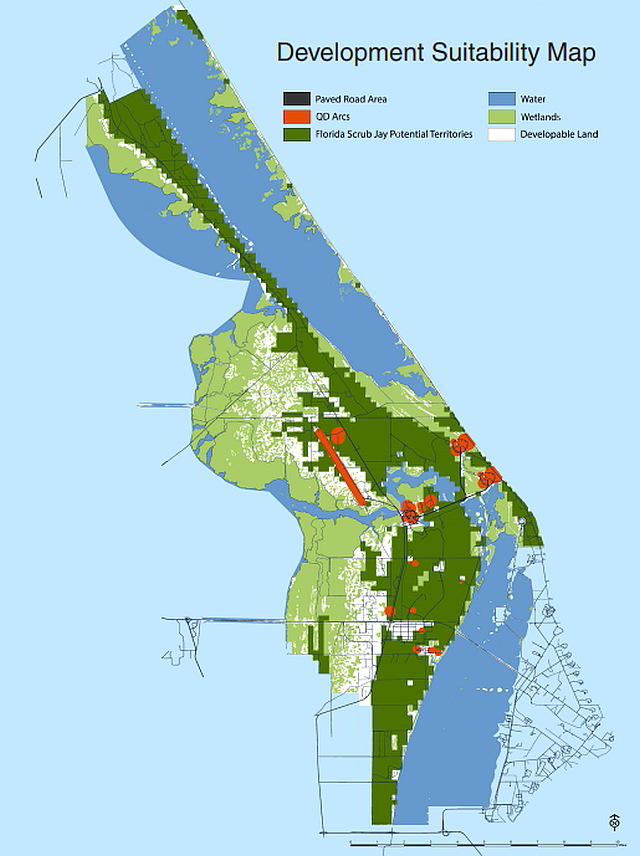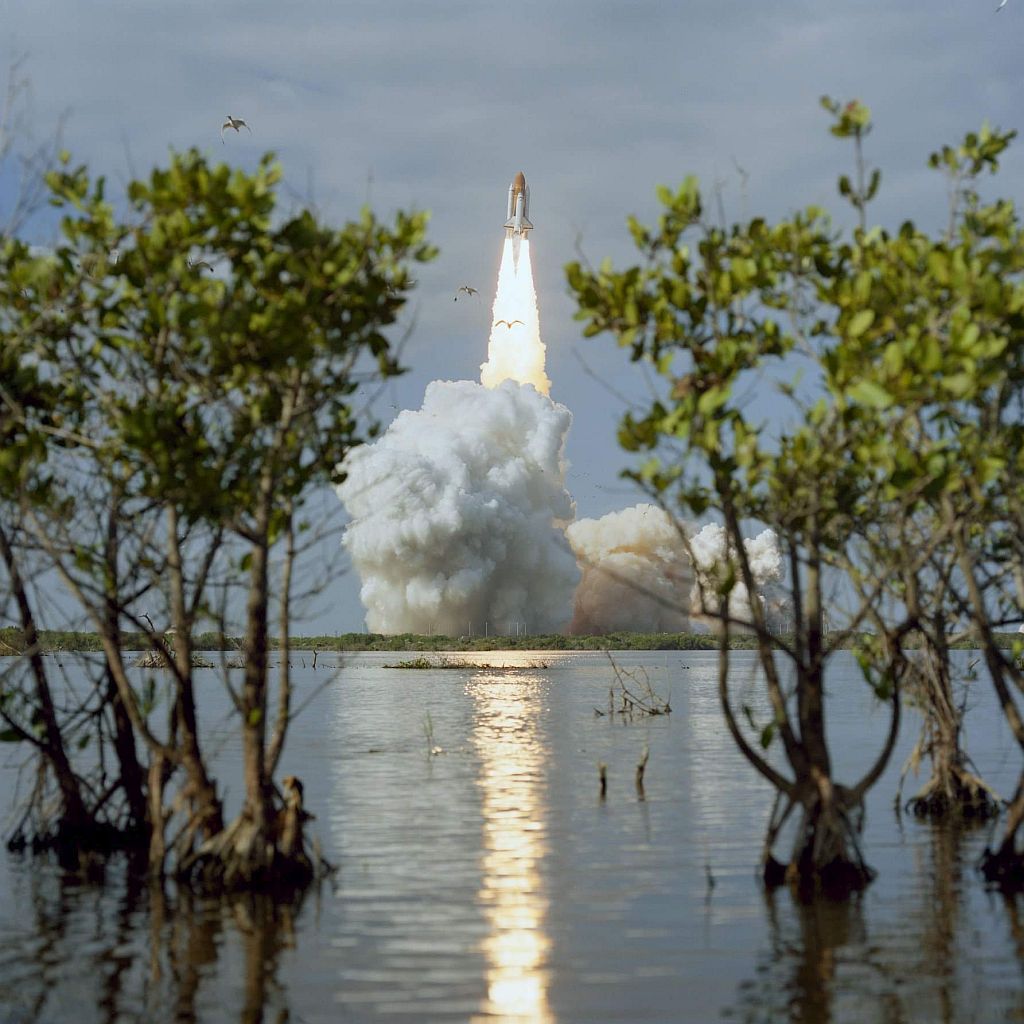Brevard Responds to DEP HangarX Wastewater Discharge Permit
On Feb. 2, 2022, the Florida Department of Environmental Protection (DEP) issued an National Pollutant Discharge Elimination System (NPDES) Notice of Draft Permit for the construction and operation of an industrial wastewater treatment facility for the Hangar X facility at Kennedy Space Center.
A public meeting will be held on April 25, 2022, to allow an opportunity for the public to provide input on the draft permit as well as ask questions and obtain information about the draft permit and permitting process.
The Hangar X NPDES Draft Permit public meeting will be held at the Cape Canaveral Public Library, 201 Polk Ave., Cape Canaveral, FL 32920 on Monday, April 25, 2022 at 4-7pm.
Public comments will not be heard but written comments will be collected at the meeting. Comments may also be emailed to the DEP at Katrina.Kasemir@FloridaDEP.gov until 7pm on April 25th.
The HangarX Wastewater Discharge permit (DEP File No. FL0A00032-001-IW7D) and public meeting requests are available on the DEP Information Portal.

 IRL Roundtable Comments
IRL Roundtable Comments
The Indian River Lagoon (IRL) within the Merritt Island National Wildlife Refuge is designated as an Outstanding Florida Water (OFW) and, as such, is protected from industrial wastewater discharges regulated through any Department of Environmental Protection (DEP) permitting program that would lower ambient water quality.
“DEP may not issue permits for indirect discharges that would significantly degrade a nearby waterbody designated as an Outstanding Florida Water.”(1)

Water Quality Degradation
Kennedy Space Center’s current 6,000 acre built environment includes 7.8 million square feet of building area.(2) Considering an average annual rain fall of 54 inches, an estimated 261M gallons of industrial stormwater is currently flowing into Banana, Indian River and Mosquito lagoons, creeks and impoundments each year.(3)
In addition, the NASA – KSC Master Plan designates another 8,000 acres for future development(4), which could, at a conservative 50% of impervious surface (226,512,000 sq ft), result in an estimated increase of 5.8B gallons annually. (3)
If NASA’s future plans for KSC are achieved, an estimated 6.1 billion gallons of industrial aerospace stormwater will flow into the IRL lagoons annually.
The spaceport’s chemical-laden stormwater contains:
- Industrial aerospace contaminants.
- Metal particulates and chemical deposition from launch emissions.
- Soot, rubber and automotive fluids from parking lots and roadways.
- Nitrogen and phosphorus from fertilizer and septic systems.
- Glyphosate from herbicides and copper from algicides and fungicides.
- Pre-KSC farm contaminants including DDT.
The DEP’s approval of this HangarX wastewater discharge permit for a seemingly innocuous discharge of HVAC condensate will, in fact, allow a retention pond to release 3,000 gallons per day of polluted industrial stormwater into a fragile estuarine ecosystem. DEP must study Oyster Prong’s current ambient water quality before permitting any discharge to the Outstanding Florida Water.
- Salinity: Even clean freshwater is pollution to a brackish waterbody.
- Alkalinity: A monitored pH balanced discharge is required.
- Turbidity: Muck flux nurtures hazardous Harmful Algae Blooms.

Cumulative Effect
DEP must consider the cumulative effect of issuing numerous individual discharge permits. This discharge permit seems trivial until annual totals (1,095,000 gallons) and the cumulative effect of many future permits (100 facilities = 109,500,000 gallons per year) are considered.
The current HangarX built environment includes 2 buildings totaling 178,000 sq ft that will produce ~2.8 MG/YR of industrial stormwater runoff in addition to the requested wastewater discharge.
It is imperative that DEP review and manage permitting the development of KSC as a system, not as a set of individual, unrelated projects. It is the cumulative effects of overall development that will hasten the decline of the IRL within KSC.
Current Stewardship

Based on data from the St Johns River Water Management District, the annual Marine Resources Council IRL Report Card continues to rate KSC waters as an F-.(5)
- Who is responsible for the spaceport’s commercial site planning and management? DEP, KSC and Space Florida must all develop strong planning and zoning regulations that protect, preserve and restore the IRL environment.
- The underfunded and understaffed DEP lacks adequate resources to permit, monitor and regulate future spaceport development on a case per case basis. A spaceport-wide process is needed.
Development Options
This wastewater discharge permit is wanted, not required. There are many better options available other than discharging industrial stormwater into the IRL National Estuary.
- Store the water and reuse it to replenish the HVAC system.
- Treat and reuse the HVAC condensate for landscape irrigation and toilet flushing.
- Construct on-site ponds to accommodate the additional 3,000 gpd of wastewater.
- Apply modern Low Impact Development techniques such as permeable parking lots and roadways that drastically reduce stormwater runoff.
IRL Roundtable Consensus
Brevard County citizens and the St Johns River Water Management District are spending millions of dollars to reverse the flow of drainage canals, construct baffle boxes and set aside water retention areas to protect the IRL estuary from chemical-laden stormwater runoff.
It is counterintuitive to our restoration efforts for DEP, KSC and Space Florida to permit commercial tenants to discharge industrial stormwater that will further degrade the quality of the Indian River Lagoon National Estuary, an Outstanding Florida Water.
 Roundtable Member Comments
Roundtable Member Comments
Below are HangarX Wastewater Discharge Permit public comments submitted by IRL Roundtable members
David Botto
I have reviewed the draft permit proposal and believe it is not a Waste Water matter. The 0.003MG/D of non-processed waste water will discharge to a stormwater infrastructure and should be considered as such. Numerous references to stormwater and stormwater management in the draft proposal itself support this conclusion. The indicated discharge will become part of a stormwater management problem by adding over 1MG/YR of waste water to stormwater run-off. Current and planned construction on this site will result in approximately 770,000 sq ft of impervious surface and produce an estimated over 20 MG/YR of fresh, polluted water entering Oyster Prong and the IRL. The total site impact on this Class II, Florida Outstanding Water Body must be considered. In addition, the draft proposal lacks data critical to informed decision making:
- Ambient water quality of receiving Oyster Prong and adjacent waters. Salinity is a water quality measure. Oyster Prong is impaired
- Current marine biology of Oyster Prong
- Functionality of named “wet retention ponds”. Design/construction specifications compliance, storage/recovery data, treatment performance, maintenance plan implementation
- Specific BMP actions of “Stormwater Pollution Prevention Plan” indicated in section VII
Consideration for “stormwater pollution prevention practices” must apply to total property impact, not just this proposed single point inflow to the NIRL. This proposal is one part of an expansive development plan for 8000 acres on KSC. The resulting approximate 5200 acres of impervious surface will add billions of gallons of run-off per year, more than doubling the current run-off of the KSC built environment. The cumulative impact of lagoon pollution must be dealt with as a system effect, not piecemeal such as this. An area standard of Low Impact Development must be applied by FLDEP to all development.
This proposal fails to consider the actual Lagoon impact of the planned built environment on the property. Every proposal review of Space Port development must consider the cumulative impact. Development contractors must meet BMAP statute requirements and prove beyond doubt that no additional pollution loads enter the lagoon post development. FLDEP has, through its own BMAP, the responsibility and the authority to require Low Impact Development (LID) rules for commercial Space Port new development (Banana River Lagoon BMAP, Section 1.5, Future Growth). Millions are being spent to correct the past mistakes that have devastated the IRL . To allow those same mistakes to continue is criminal. The catastrophic condition of the North Indian River Lagoon demands extraordinary action.
I urge FLDEP to disapprove this permit application and require a total site impact permit application.
Laurilee Thompson
For four generations, my family has made a living in Brevard County in the seafood and tourism industries. Our fishing pier, seafood markets and seafood restaurants relied on a healthy Indian River Lagoon (IRL) for success. In fact, prior to development of the Kennedy Space Center (KSC) on the barrier island and a massive increase in human population on the mainland, the IRL supported hundreds of families like ours through the commercial and recreational fishing industries and tourism activities.
Today, commercial fishing activity has nearly ceased and recreational fishing guides have fled the area for other locations where they can find fish for their clients. Founded nearly forty years ago with a menu based on local seafood products, we now serve nothing from the IRL at my restaurant.
In the early 1960s, my grandparents were among the first residents who had to relocate when the Apollo program began. Their home was on the west shore of Happy Creek, less than two miles from Launch Complex 39B. The oysters were so thick along the banks of Happy Creek that homeowners couldn’t pull their boats up to the shore. They had docks that extended out over the oyster beds to access open water. The water was crystal clear at this magical place and we caught many different species of fish from my grandparents’ dock.
As a teenager in the late 1960s, I fished gillnets in Banana Creek. A causeway had been built over the creek to accommodate the widening of SR 3 and a railroad track. Before the causeway was built, you could drive a boat from the Banana River to the Indian River through Banana Creek. A culvert was placed under the roadway for stagnant water to drain out of eastern Banana Creek’s once pristine waterways, which were now completely severed from the life-giving waters of the Indian and Banana Rivers by the Shuttle Crawlerway and the SR 3 Causeway.
At that time, oysters were still hanging on in Banana Creek. I know they were there because I couldn’t work my gillnet too close to the shoreline without tangling it in the oysters.
I could run my boat into all three prongs of Moore Creek – the dike was yet to be built that would cut it off from Banana Creek and the Indian River. And yes – there were oysters in Oyster Prong. I’m an old lady now. Heartbreak and helplessness only scratch the surface of what I’ve experienced through the decades as I’ve watched the Indian River, once one of Florida’s most productive estuaries, die.
One of the most resounding impacts to the IRL has been from the increase in freshwater and its contents. The river is definitely less salty than it was in my youth – freshwater alone from a non-natural source pollutes an estuary – added contaminants aren’t even needed to alter its delicate balance. This portion of the northern IRL is 62 miles from Sebastian Inlet. Models have shown that the residency time for water here is greater than one year. In other words, what goes in the water here stays in the water. That includes freshwater, which lowers the salinity.
Freshwater is a valuable and scarce commodity. As Florida’s population continues to grow, it will become even more precious. Florida has to stop squandering its freshwater. Surely there are better ways to utilize the freshwater that cools the air conditioning units at Hanger X rather than channeling it into a canal and ultimately into an impoundment that is connected to the imperiled IRL.
Could the extra freshwater be used for landscape irrigation? The Hanger X stormwater ponds are located 2.5 miles from Oyster Prong, which is connected to the IRL through culverts located under dikes. Is there somewhere along that 2.5-mile distance where the extra freshwater could be spread over the landscape in order to soak into the ground and into the aquifer rather than running it down a ditch to affect the Indian River?
This is just one request among many that will be received to discharge freshwater into the Indian River. When viewed as a single entity, it may not seem like a lot. But when it is added to future requests from the development of thousands of acres of KSC property, the impact to the Indian River could be overwhelming.
I ask that this discharge permit be denied and that the applicant be challenged to find a way to keep their stormwater and the cooling water from their air conditioners from going 2.5 miles down a canal and into the Indian River. Past KSC development harmed the Indian River. Please don’t allow a precedent to be set as, once again, the Kennedy Space Center enjoys monumental growth. Use this opportunity to find a better way to handle freshwater rather than adding it to the Indian River.
Sincerely,
Co-owner, Dixie Crossroads Seafood Restaurant
Titusville, FL
Public Comments
Brevard County Commission Comments
“When surface waters are designated as impaired, stakeholders including local governments are mandated to reduce annual loading. In particular, Brevard County is mandated to reduce the amount of nitrogen and phosphorus reaching the Indian River Lagoon. This permit for Space X cooling water discharge, as drafted by the Florida Department of Environmental Protection, would allow increased loading of nutrients to waters where Brevard County is already mandated by a Secretarial Order of the same agency to reduce loading to achieve federal and state adopted Total Maximum Daily Loads.”
Kristine Zonka, Chair
Brevard County Commission District 5
Read the entire Brevard Commission Comment
As the Department is aware, the Indian River Lagoon has been designated as impaired for nutrients, including nitrogen and phosphorus. These excess nutrients feed harmful algal blooms that block light from penetrating through the water to the bottom. Without sufficient light for photosynthesis, seagrass beds have shrunk by 60% and lost roughly 80% of their historical biomass in Brevard County over the last decade. Without sufficient seagrass as forage, manatees are currently starving at an unprecedented rate in an event declared by the U.S. Fish and Wildlife Agency as an “Unusual Mortality Event”.
When surface waters are designated as impaired, stakeholders including local governments are mandated to reduce annual loading. In particular, Brevard County is mandated to reduce the amount of nitrogen and phosphorus reaching the Indian River Lagoon. This permit for Space X cooling water discharge, as drafted by the Florida Department of Environmental Protection, would allow increased loading of nutrients to waters where Brevard County is already mandated by a Secretarial Order of the same agency to reduce loading to achieve federal and state adopted Total Maximum Daily Loads (see Florida Department of Environmental Protection’s North Indian River Lagoon Basin Management Action Plan, as amended).
Further, in November 2016, the voters of Brevard County approved a self-imposed 1/2 cent sales tax for the purpose of funding projects and programs to reduce pollution in the Lagoon. The Save Our Indian River Lagoon Program (SOIRL) uses revenues from the 12 cent sales tax to fund various projects to reduce pollution inputs, remove legacy loads of pollution, and restore natural filtration systems in the lagoon. Although the additional loading input proposed in this draft permit is small (up to 5.64 lbs/year of TN and 1.88 lbs/year of TP), this creates an additional burden to the Brevard County taxpayers. This burden and the associated impacts to lagoon health are of great concern to the citizens of Brevard, many of whom have reached out to their elected officials with questions and concerns about the draft permit and the implications of this new pollution source. There is also public concern about other potential pollutants including chlorine, copper, lead, iron, manganese, and zinc mentioned in the draft permit.
Due to the level of nutrient impairment of the lagoon, the recent and ongoing loss of seagrass habitat, the associated mortality of manatees and loss of marine life abundance, as well as the local responsibility to reduce excess nutrient loads, and significant community concerns regarding the draft permit, Brevard County requests that the Department hold a Public Meeting as offered in the Notice of Draft Permit which County staff received via email on February 4th, 2022.
The Board of County Commissioners appreciates the opportunity to provide the comments above and request a Public Meeting for the Department to hear the concerns of the community directly before taking final action on the proposed discharge permit. The Space Program is also vitally important to our community, our economy and our Space Coast brand. We are hopeful there is a solution that supports private investment in space while also protecting the Indian River Lagoon.
Download: Brevard County Meeting Request PDF
Brevard Soil & Water Comments
“I urge DEP to consider the impacts that this permit will have beyond what is stated as limits in the permit. One permit with limited loads will become more, and it will all add up. The IRL will continue to pay the price until we reduce the number of point loads. I encourage a public hearing be had to address these concerns, encourage the DEP to not allow any permits that increase nutrient loading to the Indian River Lagoon, and encourage alternative methods be considered.”
Chelsea Partridge, Brevard Soil & Water Supervisor
View the entire Brevard Soil & Water Comment
As this department knows, the Indian River Lagoon (IRL) is suffering due to nutrient loading, and DEP has designated it as an impaired water body. Sea grass is largely dead throughout the lagoon, manatees are dying at alarming rates, and despite a Basin Management Action Plan (BMAP) being in place for this water body, you are considering permits that will increase nutrient loads in the IRL. Nutrients feed algae blooms which leads to fish kills, and kills sea grass (the lack thereof kills manatees).
Because the IRL is an impaired water body, a BMAP has been put in place for the waterbody, and our local county has mandated nutrient reduction. Additionally, I am concerned that there are no limits on Copper and Lead. There has been recent attention on the IRL and copper, particularly regarding copper as a biocide and its impacts on sea grass. Many constituents have reached out echoing similar concerns. I encourage DEP and the applicant to consider alternatives.
The North Indian River Lagoon Basin Management Action Plan from the DEP website states in Section 1.5, titled “Future Growth In The Basin” that: “Since the North IRL is an impaired water that does not currently meet state water quality standards, new development in the basin cannot increase nutrient loads to the lagoon.” It appears to me that this permit violates the BMAP, being that the permits allows for 3.0 mg/L of Total Nitrogen and 1.0 mg/L of Total Phosphorus. The BMAP also details the previously mentioned mandate for the county to reduce nutrient loads, and the total maximum daily loads.
I urge DEP to consider the impacts that this permit will have beyond what is stated as limits in the permit. One permit with limited loads will become more, and it will all add up. The IRL will continue to pay the price until we reduce the number of point loads. I encourage a public hearing be had to address these concerns, encourage the DEP to not allow any permits that increase nutrient loading to the Indian River Lagoon, and encourage alternative methods be considered.
Chelsea Partridge, Brevard Soil & Water Supervisor
Download: Brevard County Soil and Water Request for Public Meeting PDF
References
- DEP Outstanding Florida Waters Fact Sheet
- Kennedy Space Center Overview
- Surface Water Runoff Calculations
- Kennedy Space Center Master Plan
- Marine Resources Council IRL Report Card 2022
HangarX Wastewater Discharge Resources
- HangarX Wastewater Discharge Permit Application FL0A00032
- FDEP Public Meeting Notice
- FDEP HangarX Wastewater Discharge Permit Documents
- Brevard County Request for Public Meeting
- Brevard County Soil and Water Request for Public Meeting
- Thompson Request for Public Meeting
- HangarX Site Plan
- North Indian River Lagoon Basin Management Action Plan


Once the HVAC industrial wastewater discharge enters a stormwater retention pond it becomes a stormwater discharge which requires an entirely different type of permit (surface water discharge).
An 1.5in pvc pipe and a 2hp pool pump could discharge 3k gallons of HVAC chiller water directly into the Roberts Rd ditch in under 60 minutes. Why are 16in – 24in pipes specified for this project? Because this is actually an unlimited “peak event” stormwater discharge system disguised as a wastewater discharge.
Planning and Zoning should not (may not?) approve site plans that allow surface water to discharge into any Florida waterbody.
DEP and state water management districts should not (may not?) permit surface water discharges into any Florida waterbody.